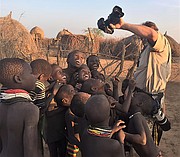International photographer’s work on display in Bigfork
TAYLOR INMAN | Hagadone News Network | UPDATED 2 years, 11 months AGO
Taylor Inman covers Bigfork and the north shore for the Bigfork Eagle and hosts News Now and other podcasts for the Daily Inter Lake. Originally from Kentucky, Taylor started her career at the award-winning public radio newsroom at Murray State University. She worked as a general assignment reporter for WKMS, where her stories aired on National Public Radio, including the show “All Things Considered.” She can be reached at 406-758-4440 or at [email protected]. | January 4, 2023 11:00 PM
Bruce Miller grew up in Montana with a love of photography, now he travels the world in search of people and places that challenge the imagination and break preconceptions.
Miller has been published internationally, and now a collection of his work is on display at the Bigfork Art and Cultural Center.
Miller is currently based in Idaho, but much of his work takes place overseas. After a trip to Africa reignited his love for photography in 2006, he and his wife began their work in conservation. An artist in her own right, his wife has a career writing children’s books based around issues of conservation. They often travel to parts of Africa, India and more to work with different groups, such as Elephants Without Borders in Botswana and the African Wildlife Federation. Three of his images from Africa were selected and published in the Africa Geographic 2017 Yearbook and he was an Africa Geographic Photographer of the Year finalist for 2019.
Miller said he contributes photographs to these groups for their conservation efforts. Also participating in Photographers Without Borders, his work on their human-elephant conflict project has been featured by the Sri Lanka Wildlife Conservation Society.
When it comes to conservation, Miller is drawn to documenting his subjects in the complexity they live in, highlighting multiple issues at once.
“As soon as you start to look at wildlife issues, then you start to look at habitat issues — and the conflicts are always with people and those habitats. So you really broaden your perspective in terms of what conservation really means. My interests have kind of gone beyond just trying to take great images of certain types of wildlife, to how that translates into really broader conservation efforts and making a difference in that perspective,” Miller said.
In addition to his work photographing wildlife and landscapes, Miller has spent time with some very remote indigenous communities in Africa. He’s taken trips to the Omo Valley in Ethiopia, among other villages, to learn about their culture and document their traditions. He said there’s a certain way to go about photographing people to ensure he is respecting boundaries and etiquette.
“You're not necessarily sticking a camera in their face, you try and engage with people, to the extent you can with language barriers. You also need someone that's going to be able to speak the language ... And then beyond that, it's a lot of the same type of skills, you try to engage with people on a personal level before you start taking pictures,” Miller said.
He said occasionally they have to get permission from a tribal elder, or someone in a position of authority, to take photos in a village. But he relies on local experts to help him get the best photos on these trips.
“Putting all that together and engaging with people — and lots of smiles along the way obviously helps, too,” Miller said.
Miller said he tries to bring an element of storytelling to the photographs. He will often put storyboards alongside an exhibit to provide context, which will also be available alongside photographs he took of indigenous tribes at his BACC exhibit.
It’s the first time this collection of Miller’s photographs has been displayed together. He’s held exhibits in Myanmar, Papua New Guinea and Ethiopia, but he’s never had one in Montana.
“I've had a really good response in other locations. These are places people will probably never visit, but it's just really interesting to get their reaction to indigenous cultures from other parts of the world. And then obviously, there's indigenous tribes in northwest Montana. So I'm just really interested in seeing how it all comes together and how it's received,” Miller said.
“Cultures and Land in Transition” will feature photographs of wildlife, landscapes and people. The wildlife section includes photos from several continents and species including Africa, Borneo, and India. The “Water is Life” portion will feature images of the Earth’s water sources from Antarctica and the Arctic region of Greenland and Iceland, to the tropical Pacific Ocean and the Belize Barrier Reef Reserve System. The “Cultures and Tradition” collection highlights three cultures, the tribes of the Omo Valley in Ethiopia, Burmese and tribes of Papua New Guinea.
Miller’s work is on display at the BACC through Feb. 23.
More information about Miller and Naturally Wild Photography can be found on his website naturallywild.com.
ARTICLES BY TAYLOR INMAN

Blacktail Mountain Ski Area sets opening for Christmas Eve
Christmas Eve will mark the start of seven-day-a-week operations, which will continue through Jan. 4, according to a release from the ski area.

Christmas magic: Lakeside resident spreads cheer with elf character
Silver Belle is always excited to meet new people and help them get up to the North Pole to meet Santa Claus during the Journey to the North Pole cruises, which take place every holiday season on Lake Coeur d'Alene.

Christmas magic: Lakeside resident spreads cheer with elf character
Silver Belle is always excited to meet new people and help them get up to the North Pole to meet Santa Claus during the Journey to the North Pole cruises, which take place every holiday season on Lake Coeur d'Alene.



